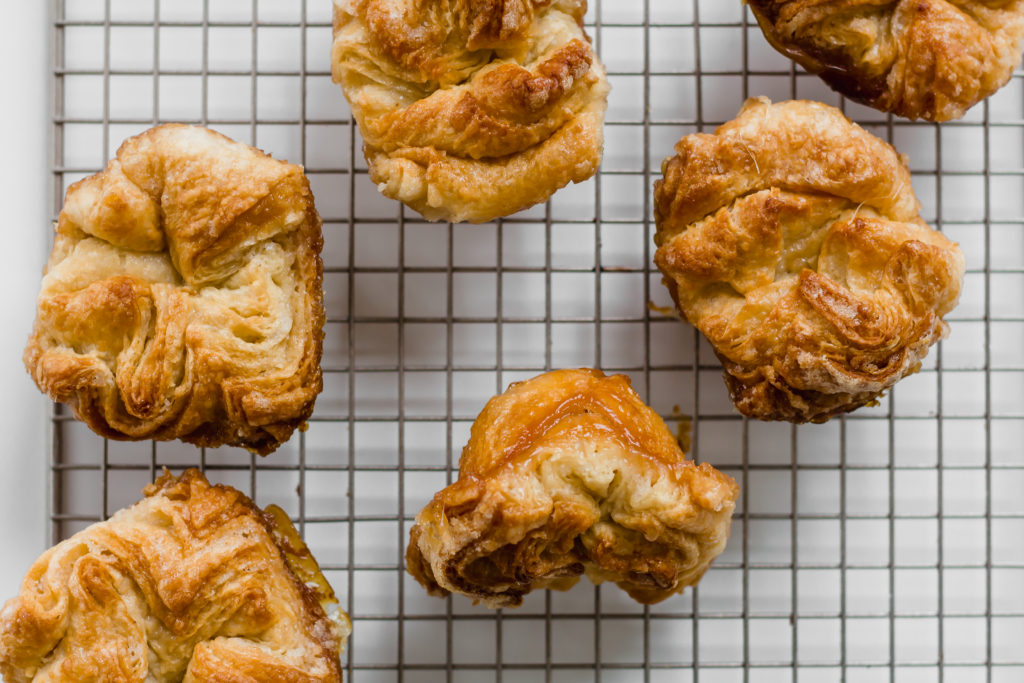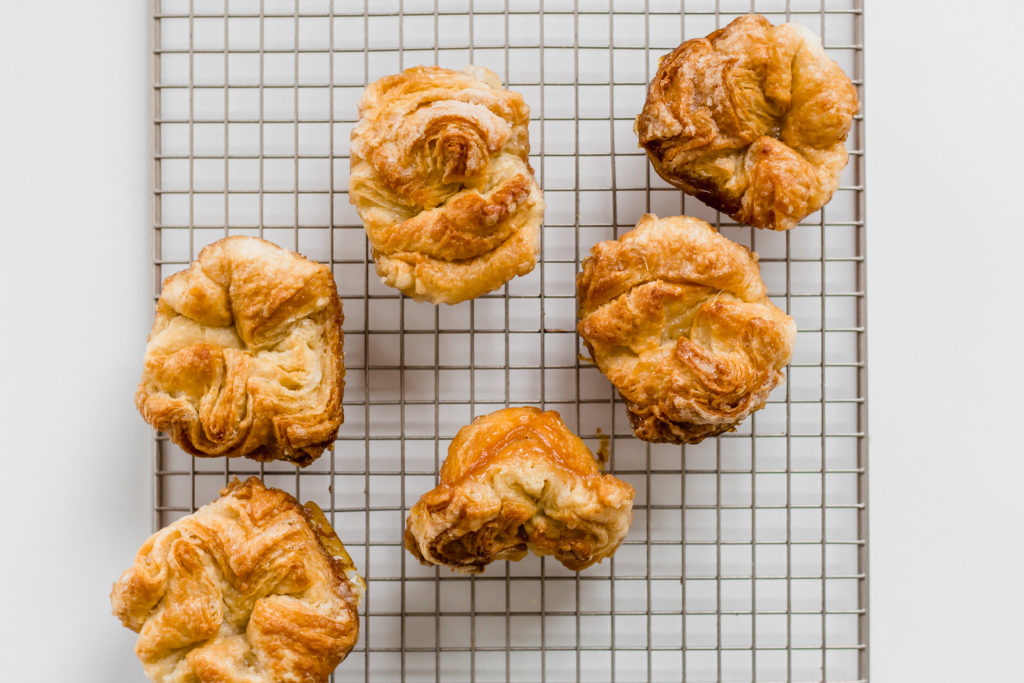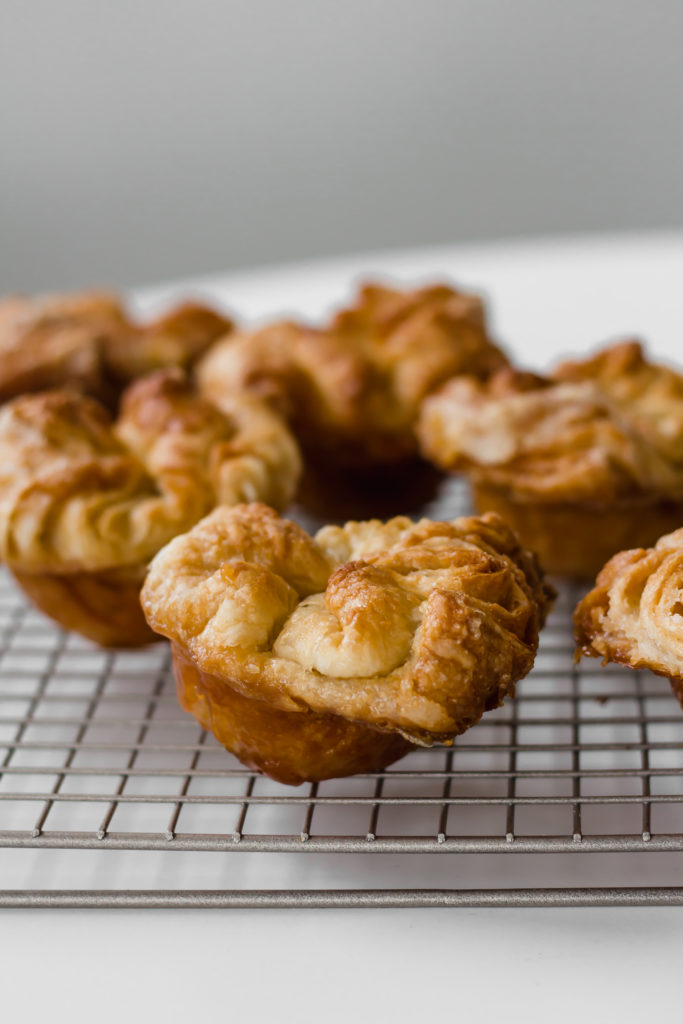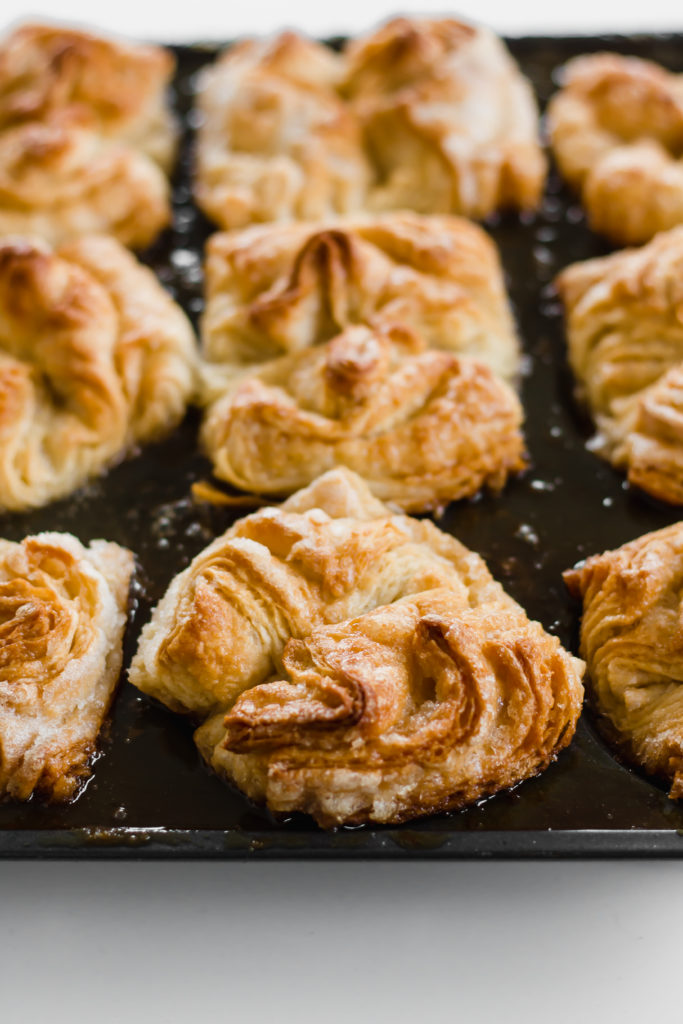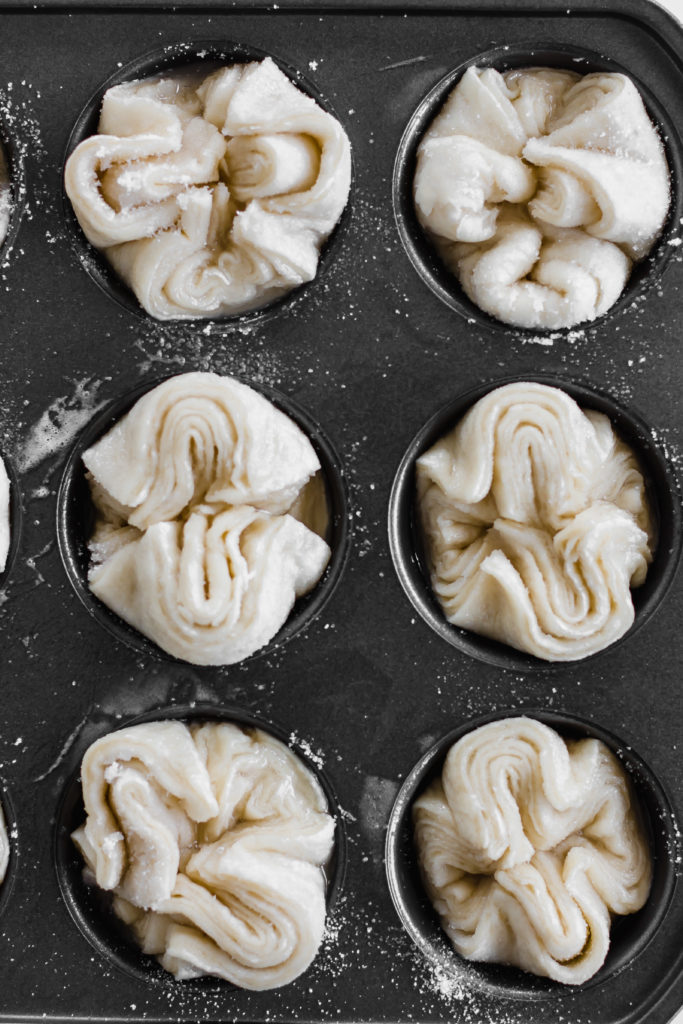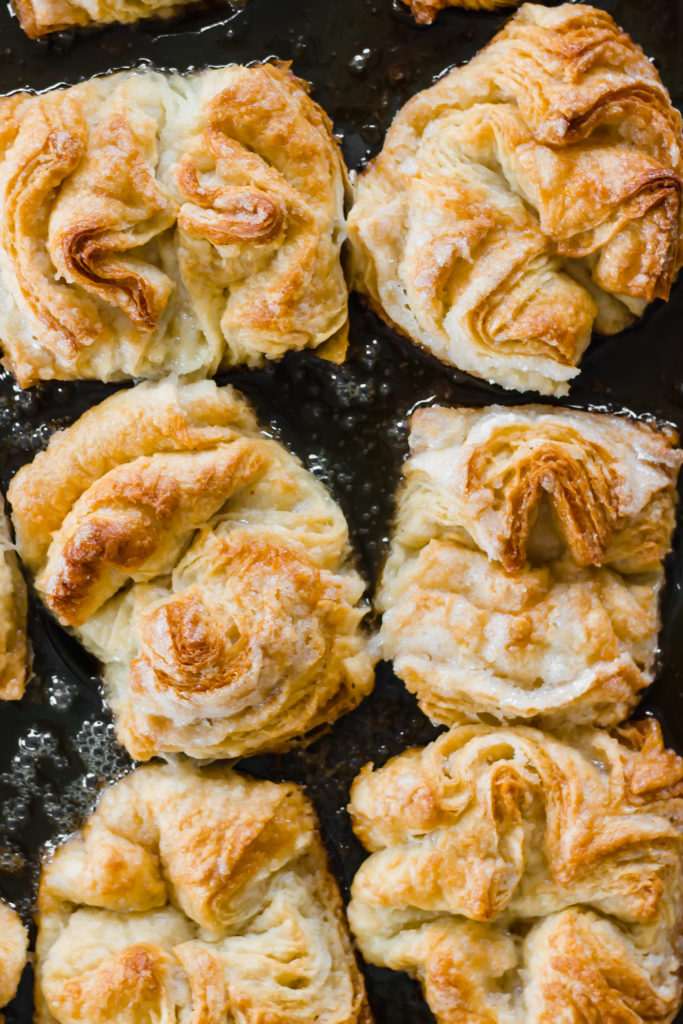One of the best bites you’ll ever have: the kouign-amann is a croissant-like pastry with layers-upon-layers of buttery, flaky sweet dough with a sugary crisp top and a caramelized sticky bottom.
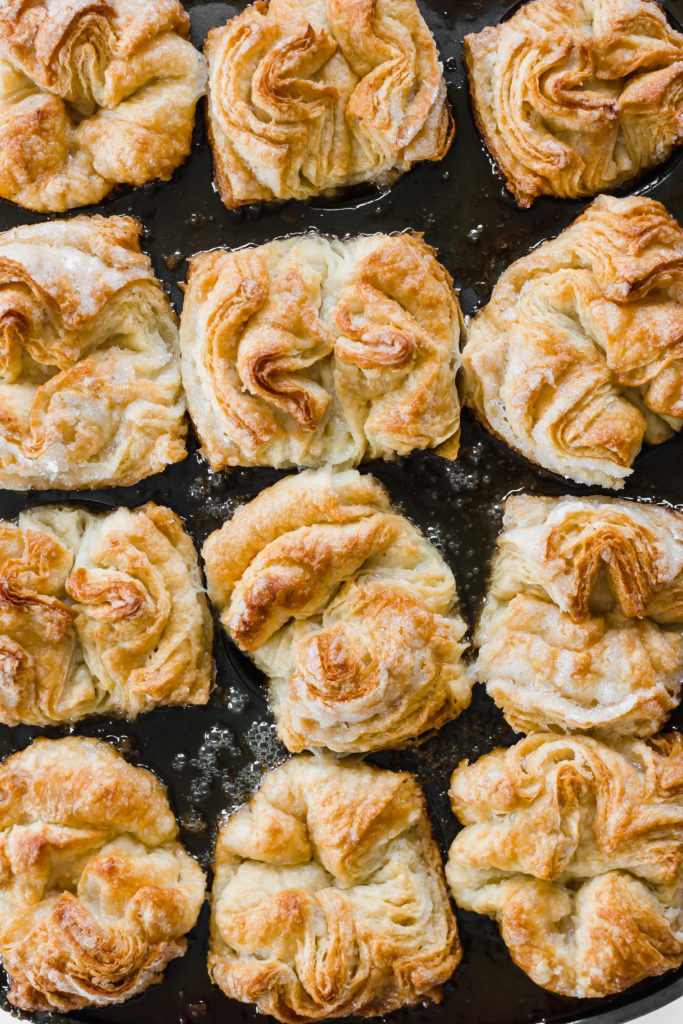
I can’t even remember the first time I ate one of these perfect pastries because I was swirled immediately into a doughy dreamland. It was the most luscious bite I’d ever experienced and I knew right away it was my new favorite.
So, What Is a Kouign-Amann?
The kouign-amann pastry (which is pronounced like QUEEN A-MAHN) is a French pastry that originates from the Brittany region of the country. This is why you may also see it referred to as “breton butter cake.” “Kouign-amann” actually comes from the local Breton terms for “butter” and “cake” so you know it going to be good. I’ve heard that it is typically baked into one large round cake shape but any time I have seen it at a bakery, or have made it myself, it is in muffin-like form.
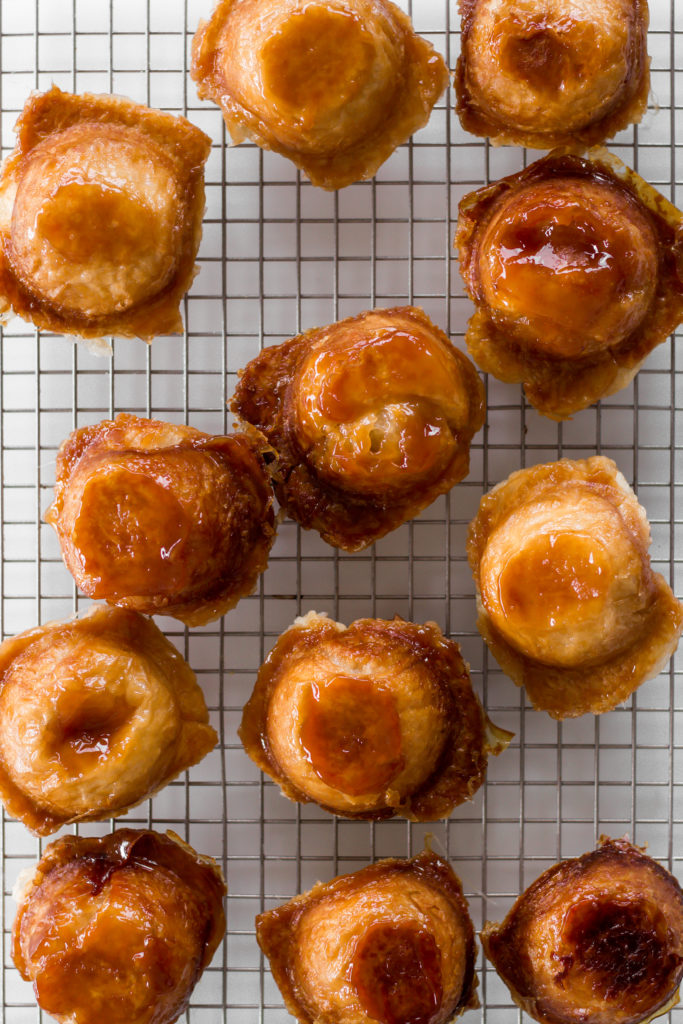
Making It at Home
This is the best kouign-amann recipe that I have found in my tests and is adapted slightly from Joanne Chang in the Flour, Too cookbook. First, you’ll bake the dough base, let it rise, and chill it so it will be easier to roll out. Then, once rolled, you will smear it with a layer of butter. Then comes the folding and rolling lamination process. This is critical to getting flaky layers of dough when you bake. Near the end of your folding and rolling, you introduce some granulated sugar so that some of the layers are lined with sweetness. Lastly, you’ll cut the laminated dough into squares and dip them into (yes, seriously) more sugar, let them rise in a muffin pan, bake, take a bite, and enter dreamland.

Kouign-Amann Pastry Recipe
Recipe from Flour Bakery
Makes 12 small cakes
Ingredients:
1 1/4 teaspoon active dry yeast
2 3/4 cups (385 grams) all-purpose flour
1 1/4 teaspoon table salt
1 cup (2 sticks or 225 grams) unsalted butter, at room temperature (it should be very spreadable)
1 1/2 cups (300 grams) granulated sugar, plus more for rolling and coating
Instructions:
- In the bowl of a stand mixer fitted with a dough hook, mix together the yeast and 1 cup warm water (about 110°F) until the yeast dissolves and the mixture gets a little foamy indicating the yeast is active. If the yeast doesn’t foam, discard and start again.
- To the bowl with the yeast, add the flour, salt, and 1 tablespoon melted butter and mix on low speed for 3 to 4 minutes, or until the dough comes together and is smooth. (If the dough is too wet, add 2 to 3 tablespoons of flour; if it is too dry, add 2 to 3 teaspoons of water.) The dough should be soft and supple and should come away from the sides of the bowl when the mixer is on.
- Transfer the dough to the lightly greased bowl and cover with plastic wrap. Allow to proof in a warm area for 1 hour. Then transfer the dough to the fridge and proof it for another hour.
- Transfer the dough from the fridge to a generously floured work surface. Roll it into a rectangle about 16 in/40.5 cm wide and 10 in/25 cm from top to bottom. With your fingers, or a small spatula, press or smear the room-temperature butter all over the right half of the dough. Fold the left half of the dough over the butter, and press down to seal the butter between the dough layers. Turn the dough 90 degrees clockwise so that the rectangle is about 10 in/25 cm wide and 8 in/20 cm top to bottom, and flour under and on top of the dough.
- Slowly begin rolling the dough from side-to-side into a rectangle about 24 in/61 cm wide and 12 in/30.5 cm from top to bottom. If the dough is sticky, feel free to continue flouring the surface as needed to prevent the rolling pin from sticking. Once it is rolled, lift the right third of the dough and flip it over onto the middle third. Then lift the left third of the dough and flip it on top of the middle and right thirds (like folding a business letter). Your dough should now be about 8 in/20 cm wide, 12 in/30.5 cm from top to bottom, and about 11⁄2 in/4 cm thick. Rotate the dough clockwise 90 degrees; it will now be 12 in/30.5 cm wide and 8 in/20 cm from top to bottom, with the folded seam on top. This process of folding in thirds and rotating is called turning the dough.
- Repeat the process once more, patiently and slowly rolling the dough into a long rectangle, flipping it upside down as needed as you roll it back and forth, and then folding the dough into thirds. The dough will be a bit tougher to roll out and a bit more elastic.
- Return the dough to the baking sheet and cover it completely with plastic wrap, tucking the plastic wrap under the dough as if you are tucking it into bed. Refrigerate the dough for about 30 minutes. This will relax the dough so that you’ll be able to roll it out again and give it more turns. Don’t leave the dough in the fridge much longer than 30 minutes or the butter will harden too much and it won’t roll out properly.
- Remove the dough from the refrigerator and place it on a well-floured work surface with a long side of the rectangle facing you and the seam on top. Again, roll the dough into a rectangle about 24 in/61 cm wide and 12 in/30.5 cm from top to bottom. Sprinkle 3⁄4 cup/150 g of the sugar over the dough and use the rolling pin to gently press it in. Give the dough another fold into thirds and turn as directed previously. The sugar may spill out a bit. That’s okay, just scoop it back in.
- Once again roll the dough into a rectangle 24 in/61 cm wide and 12 in/30.5 cm from top to bottom. Sprinkle the remaining 3⁄4 cup/150 g sugar over the dough and use the rolling pin to press the sugar gently into the dough. Give the dough one last fold into thirds and turn. Return the dough to the baking sheet, cover again with plastic wrap, and refrigerate for another 30 minutes.
- Meanwhile, liberally butter the cups of the muffin tin and set aside.
- Remove the dough from the refrigerator. Sprinkle your work surface generously with sugar, place the dough on the sugar, and sprinkle the top with more sugar. Roll the dough into a long rectangle 24 in/61 cm wide and 8 in/20 cm from top to bottom. The sugar will make the dough gritty and sticky, but it will also make the dough easier to roll out. Using a chef’s knife, cut the dough in half lengthwise. You should have two strips of dough, each 24 in/61 cm wide and 4 in/10 cm from top to bottom. Cut each strip into six 4 in/10 cm squares.
- Working with one square at a time, fold the corners of the square into the center and press down so they stick in place. Shape and cup the dough into a little circle, and press the bottom and the top into more sugar so that the entire pastry is evenly coated with sugar. Place the dough circle, folded-side up, into a cup of the prepared muffin tin. It will just barely fit. Repeat with the remaining squares. Cover the tin with plastic wrap and let the cakes proof in a warm place (78°F to 82°F/25°C to 27°C is ideal) for 1 hour to 1 hour and 20 minutes, or until the dough has pouffed up.
- About 20 minutes before you are ready to bake, preheat the oven to 400°F/200°C, and place a rack in the center of the oven.
- When the dough is ready, place the muffin tin in the oven, reduce the heat to 325°F/165°C, and bake for 30 to 40 minutes, or until the cakes are golden brown. Remove the cakes from the oven and let them cool just until you can handle them, then gently pry them out the muffin tin onto a wire rack and leave them to cool upside down. They are extremely sticky and will stick to the muffin tin if you don’t pop them out while they are still warm. Let cool completely before serving.
